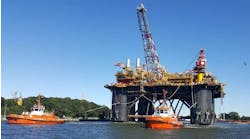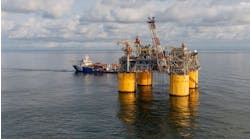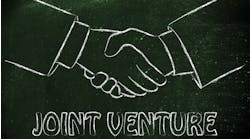Stability, but no PSCs or oil price risks
Neil Potter
Corresponding Editor
- Iran has 20 discoveries and 14 developments in its offshore territorial waters that will be offered. [65,653 bytes]
- ESPs are planned for Iran's Serri-D field, which is presently producing 14,000 b/d. [41,939 bytes]
- Some of the productive formations offshore Iran. [27,535 bytes]
Some 65 oilfield onshore and 20 offshore have been discovered, of which 37 onshore and 14 offshore are development fields. In natural gas, 23 giant gas fields have been discovered, of which only 16 fields are being developed. Thus, there is enormous potential for growth. But there is, as Iran itself realizes, a wide gap between reserves and production.
Finance and technology are needed to bridge that gap. Iran does not have the cash to develop new fields, reinvigorate production from some of its ageing fields, or carry out offshore exploration by itself. So it took a step which, not so long ago, would have been unthinkable- threw open these immense oil and gas resources to foreign companies.
Outside participation
Following the involvement of Total, Gazprom, and Petronas in the South Pars Phase 2 and 3 gas field development (after the US banned Conoco's deal ), Iran knew that foreign companies were lurking in the wings, waiting for an opportunity to move in. Shell and BP have both said openly they want to re-establish ties with Iran. Saga of Norway has now joined the queue.But the shadow of US sanctions and the terms and projects on offer were not seen as particularly attractive. Then came the US decision to waive sanctions against EU companies investing in Iranian oil and gas.
At the same time, there is a new attitude toward foreign investment by the 1997-elected President Khatami. "Foreign investment can bring us security and stability", he has said. The struggle between traditional conservative
fundamental Islamic interests and the moderates continues, but all the signs indicate that changes are taking place, albeit slowly.
In February, the Majlis (Iran's parliament) authorized the oil ministry to conclude $5.5 billion of investments in projects with foreign companies in this financial year, which ends on March 20, 1999.
How to present the projects to the world? The NIOC requested the Energy Division of IBC Technical Services to organize a conference and workshops. A delegation from the NIOC, led by Mehedi Hosseini, deputy oil minister, came to London to present Iran's agenda to some 450 oil executives representing 150 companies.
Forty projects
Details were provided on more than 40 projects, including 17 onshore and offshore exploration blocks, 8 offshore developments, and 14 onshore fields. It is the first time since the Islamic revolution of 1979, that Iran is allowing foreign companies to participate in its onshore fields.Hosseini said that overall, these development projects could attract $8 billion of foreign investment: $3 billion offshore and $5 billion onshore. This excluded investment in the 17 exploration projects " I do not see any problems for banks to provide finance", he said. Iran's energy officials hope to have finalized some contracts within two months.
Hosseini said that the package of projects unveiled, which could add around 1.4 million b/d to the production capacity, was not a "one-off offer. We won't limit ourselves to these," he said. "We expect next year's budget to sanction more projects," He said that no projects would be reserved for US companies in anticipation of the lifting of the ban on investment. "We cannot wait for them," he added.
Offshore, there are eight development projects on offer, mostly aimed at boosting production from aging fields (one almost 40 years old) by 3D seismic, re-entry into existing wells for recompletions as horizontal wells, infill drilling from new drilling platforms, gas lift systems, water injection, and improvement of downhole pumping performance (ESPs).
There are six producing fields. These are, with the date of first production:
- Soroosh (1967), 80 km WSW of Kharg Island
- Salaman (1968 ), 150 km SW of Lavan Island on the Iran/Abu Dhabi median line
- Hendjan (1959) in the northern most part of the Gulf
- Sirri C & D (1978), 35 km off Sirri Island
- Nowrooz (1970), 95 km SW of the Bahregan Oil Centre onshore.
Projects/upgradings
The Esfandir field,discovered in 1965, 95 km SW of Kharg Island, with an estimated 220-491 million bbl in place, has not yet been developed. The Phase 1 project calls for 3D seismic, drilling and completion of two wells to be put on long term production test.The workscope includes design, fabrication, and installation of a 4-legged wellhead platform and a 30 km, 12-in. pipeline to the Foroozan field production platform. Expected production on test is put at 6,500 b/d.
On the Soroosh field, most of the platforms and facilities were damaged, some beyond repair, during the Iran/Iraq war. Renovation of the field was the subject of a buyback project presented in the first round in 1995. A nominated Iranian contractor, IOEC/PEDEC, is currently carrying out the work, which includes four renovated structures and one new wellhead platform. First production is targeted for 2001 at 60,000 b/d from 9 wells with ESPs - a mere 5-7% recovery rate, with the oil going to the FPSO. The NIOC believes this could be boosted to 100,000 b/d, and ultimately to 150,000 b/d.
The new buyback project includes laboratory analysis to evaluate and select the best methods for improving recovery as well as consideration of gas and water injection and thermal recovery. The field development scheme could include 2-3 new platforms, upgrading the processing facilities on the FPSO and drilling 4-6 horizontal wells.
The South Pars gas field, where the reservoir is shared with Qatar, has proved gas reserves of more than 280 Tcf in Iranian waters. Phase 1 is being developed by IOEC/PEDEC, and Phase 2 and 3 by the Total/Gasprom/Petronas consortium. Development of phases four and five, now on offer, is planned to produce an additional 1 Bcf of gas, with condensate, in each phase. Twenty producing wells will be drilled from two platforms. Production from each will be diverted into a single 100-km, 32-in. pipeline with a 4 1/2-in. piggy-back line for chemical injection and sent to the onshore plant. It is proposed to transfer the well fluid in 3-phase, without any offshore processing. Gas will enter the pipeline with 2000 psi and arrive onshore at estimated pressure of 1425 psi in order to control corrosion in the pipeline. A limited number of facilities installed for Phase 1 development will be utilized.
Present production from Sirri C & D oil fields is around 28,000 b/d (14,000 b/d from each field) with subsequent increase to almost 50,000 b/d by utilizing ESPs in all producing wells.The original oil in place was estimated at 486 million bbl (Sirri C) and 693 million bbl (Sirri D), out of which 51 million bbls have been produced from C and 103 million bbl from D.
NIOC Offshore plans to maximize production by implementing modifications to the downhole pumping systems, optimization of water injection systems and performing additional infill drilling. NIOC believes plateau production of 70,000 b/d could be achieved and sustained for three years before approaching reservoir decline.
Recent simulation studies on Sirri D indicate a requirement for drilling five additional producers as well as increasing the water injection capacity. The proposed workscope includes 3D seismic, evaluation of the water injection scheme, modification of the pumping systems, infill drilling (both producers and injectors), and a capacity increase of water injection system of an additional 40,000 b/d.
Offshore facilities consist of 8 multi-well drilling platforms, a production,utility, and accommodation platform. There is only one stage separation offshore with the oil and gas transferred to Sirri Island through independent pipelines. Water injection facilities with a capacity of 80,000 b/d are installed onshore.
Among the exploration projects there are three offshore blocks, where the minimum expected work scope includes 2D and 3D seismic and the drilling of two wells. The East Kish block is to the east of the Pars platform and covers 6,290 sq km in the eastern part of the Gulf. The Qeshm block is 3,180 sq km, close to the Iranian coastline and close to the island of Qeshm and the entrance to the Gulf. The Hormoz block is 3,360 sq km opposite the tip of Oman, which reaches into the Straits of Hormoz.
Production realities
If all this sounds wonderfully attractive, there are snags. Hosseini spelled out one very clearly: "We will not allow foreign companies to operate fields when they are in production." There is no way in which Iran will negotiate the traditional production sharing contract with outside companies.Article 81 of Iran's Constitution states: "The granting of concessions to foreigners for the formation of companies or institutions dealing with commerce, industry, agriculture, services, or mineral extraction is absolutely forbidden." In other words, there is no way that foreign companies can "own" any reserves.
So, the Iranians devised their buyback system, under which, in effect, the oil companies become contractors. They will finance specific projects with repayment, including an agreed rate of return on investment, taking place over a specified period from a field's production. The period is likely to be around five years and the rate of return between 15-20%.
Hosseini points out: "When we started inventing these contracts, we determined on a compromise between us and the expectations of the oil companies. Buyback schemes are becoming recognized internationally and gradually accepted. We do not expect any serious difficulties.
"The oil companies will have access to crude oil and security of supply as we will offer long-term supply contracts." But the foreign companies will not be able to show such reserves on their balance sheets. One redeeming feature is that the oil price risk is constant under the buyback regime.
It is perhaps not surprising that Dr.Faramarz Ghardiri, NIOC's managing director for the central fields onshore, pointed out: "Joining with Iranian partners, and using Iranian materials as far as possible, is considered to be a great advantage in awarding the contract to a successful bidder or tenderer."
Iran has 20 discoveries and 14 developments in its offshore territorial waters that will be offered.
Copyright 1998 Oil & Gas Journal. All Rights Reserved.


